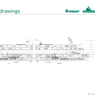New Ax-Bow to Increase Ships' Efficiency
NKK Corp. has developed the ax-shaped bow that allows a reported 20 to 30 percent reduction in ships' sea margin compared with conventional bows.
The company will fit the new bow to a 172,000-dwt Capesize bulk carrier that is currently under construction at the yard's Tsu Works, being built for Mitsui OSK Lines. As ship operators increasingly demand more efficient operation, particularly under rough conditions, NKK decided to focus on how to reduce a ship's resistance on the bow above the still water surface. In 1996, teaming with Osaka University marine engineering researchers, the company developed a sharp-edged bow, which proved effective cutting through waves and reducing sea margin.
NKK has continued model tests of the Ax-Bow with partial funding from the Ship & Ocean Foundation, and confirmed that the Ax-Bow can reduce a ship's sea margin by 20 to 30 percent. The bulk carrier is to be delivered in June 2001.
The team found that, in order to decrease the diffraction of waves at the bow, it is necessary to reduce the bluntness of the bow shape, especially above the still waterline. To design the optimum bow shape under various practical restrictions, an estimation method of added resistance due to wave considering hull shape above the waterline is needed.
One solution formulated was the Beak-Bow, so named for its similarity to the appearance of a bird's beak. It entailed a sharp and extended triangular shaped bow above the waterline, which served to effectively reduce wave resistance.
From a practical standpoint, however, it in some cases added too much length to the ship. For example, in the case of a 170,000-dwt bulk carrier, the ship length became 984 ft. (300 m) with the Beak-Bow, which made the ship, by regulation for its size/type, 36 ft. (11 m) too long to enter a European port. The shape was then modified to form the Ax-Bow, a bow shaped modified to shape the waterline as sharp as possible, keeping the profile of the bow as a solid line. It also, by nature of its shorter profile, helps to ensure that ships stay within length regulations.













